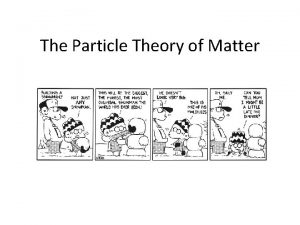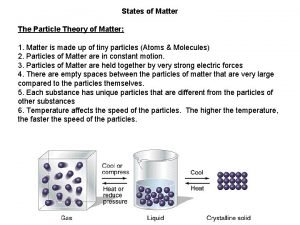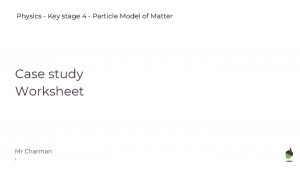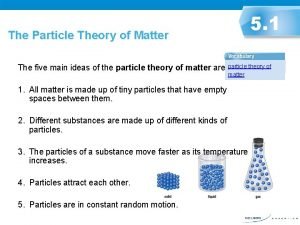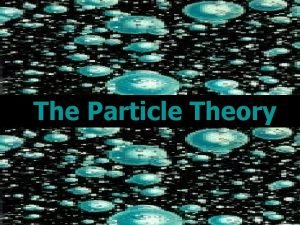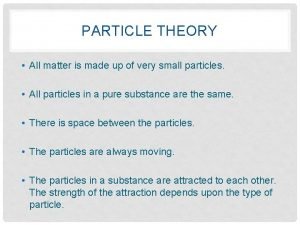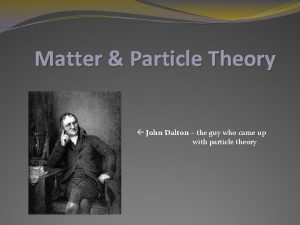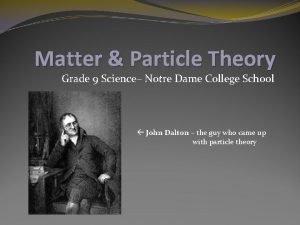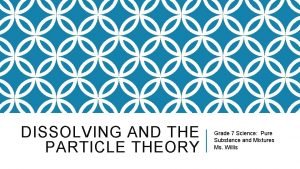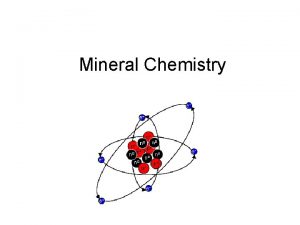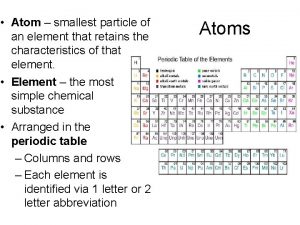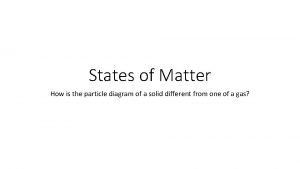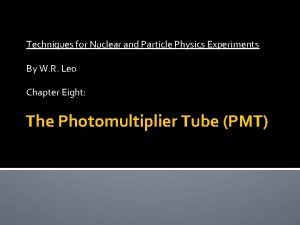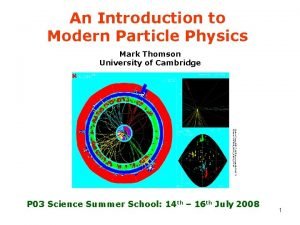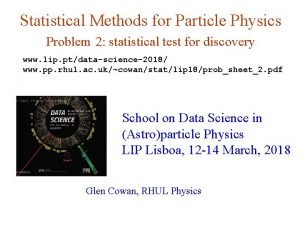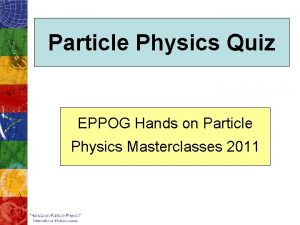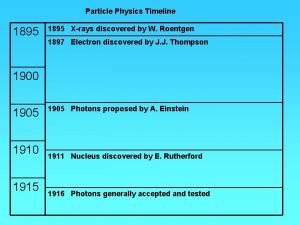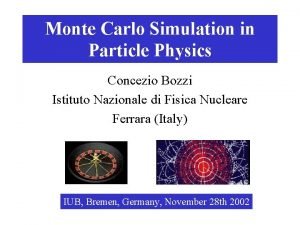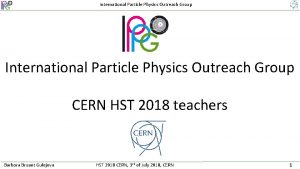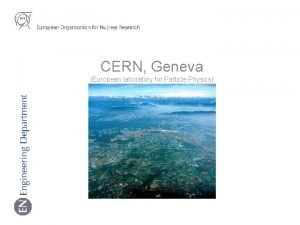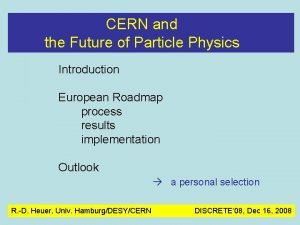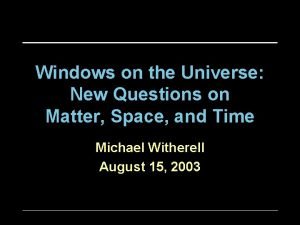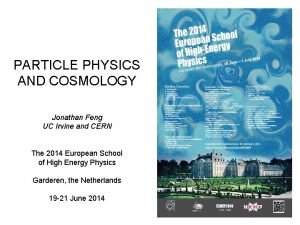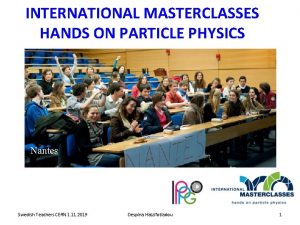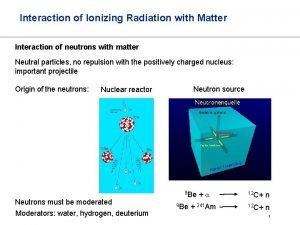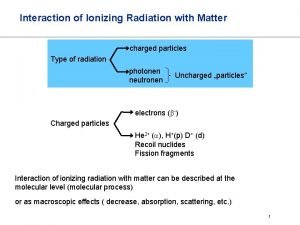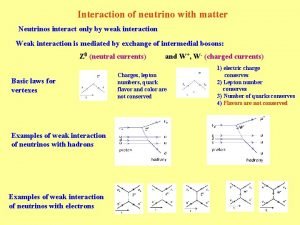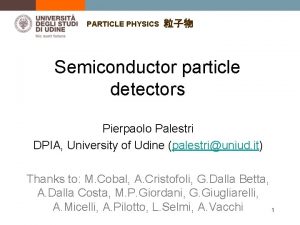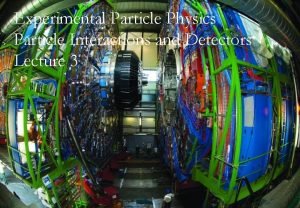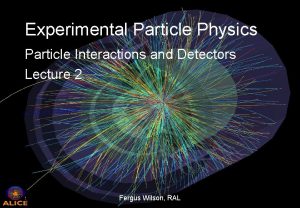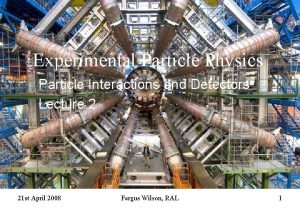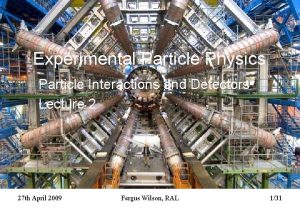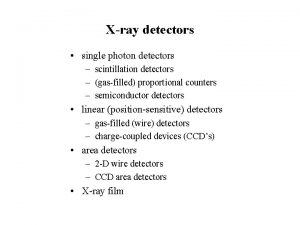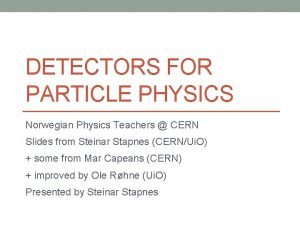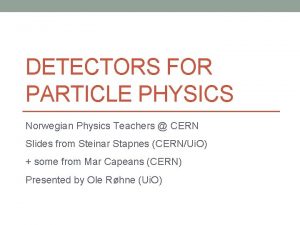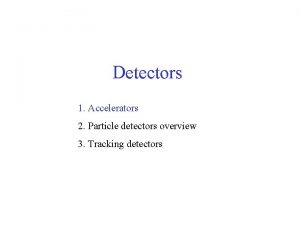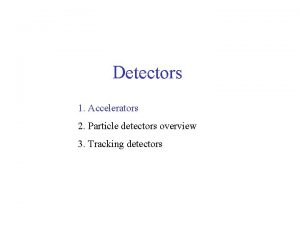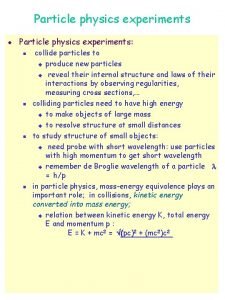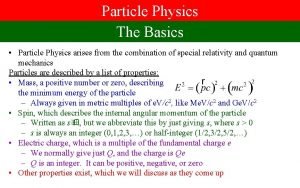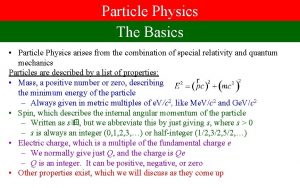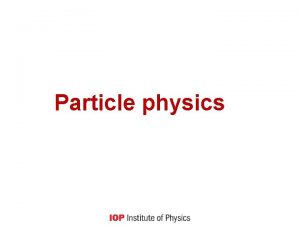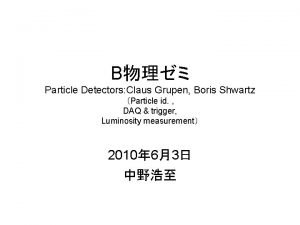Detectors for Particle Physics Interaction with Matter D







![Understanding Bethe-Bloch d. E/dx falls like 1/β 2 [exact dependence β-5/3] – Classical physics: Understanding Bethe-Bloch d. E/dx falls like 1/β 2 [exact dependence β-5/3] – Classical physics:](https://slidetodoc.com/presentation_image_h/b68b36674e063d25a2f2d2430669b58f/image-8.jpg)



































![Bohr’s Classical Derivation Determination of relevant range [bmin, bmax]: [Arguments: bmin > λe, i. Bohr’s Classical Derivation Determination of relevant range [bmin, bmax]: [Arguments: bmin > λe, i.](https://slidetodoc.com/presentation_image_h/b68b36674e063d25a2f2d2430669b58f/image-44.jpg)
![Bohr Calculation of d. E/dx Stopping power Determination of the relevant range [bmin, bmax]: Bohr Calculation of d. E/dx Stopping power Determination of the relevant range [bmin, bmax]:](https://slidetodoc.com/presentation_image_h/b68b36674e063d25a2f2d2430669b58f/image-45.jpg)


- Slides: 47

Detectors for Particle Physics Interaction with Matter D. Bortoletto Purdue University 1

Detecting particles Every effect of particles or radiation can be used as a working principle for a particle detector. Claus Grupen D. Bortoletto Lecture 2 2

Example of particle interactions Ionization Pair production Compton scattering Delta-electrons D. Bortoletto Lecture 2 3

EM interaction of particles with matter Ze- M, q=z|e-| Interaction with the atomic electrons. Incoming particles lose energy and the atoms are excited or ionized. Interaction with the atomic nucleus. Particles are deflected and a Bremsstrahlung photon can be emitted. If the particle’s velocity is > the velocity of light in the medium Cherenkov Radiation. When a particle crosses the boundary between two media, there is a probability ≈1% to produce an X ray photon Transition radiation. D. Bortoletto Lecture 2 4

Energy Loss by Ionization Assume: Mc 2 ≫ mec 2 (calculation for electrons and muons are more complex) Interaction is dominated by elastic collisions with electrons – The trajectory of the charged particle is unchanged after scattering Energy is transferred to the δ-electrons Energy loss (- sign) Classical derivation in backup slides agrees with QM within a factor of 2 D. Bortoletto Lecture 2 5

Energy loss by ionization The Bethe-Bloch equation for energy loss D. Bortoletto Lecture 2 6

The Bethe. Bloch Formula PDG Common features: – fast growth, as 1/β 2, at low energy – wide minimum in the range 3 ≤ βγ ≤ 4, – slow increase at high βγ. A particle with d. E/dx near the minimum is a minimumionizing particle or mip. The mip’s ionization losses for all materials except hydrogen are in the range 12 Me. V/(g/cm 2) – increasing from large to low Z of the absorber. D. Bortoletto Lecture 2 7
![Understanding BetheBloch d Edx falls like 1β 2 exact dependence β53 Classical physics Understanding Bethe-Bloch d. E/dx falls like 1/β 2 [exact dependence β-5/3] – Classical physics:](https://slidetodoc.com/presentation_image_h/b68b36674e063d25a2f2d2430669b58f/image-8.jpg)
Understanding Bethe-Bloch d. E/dx falls like 1/β 2 [exact dependence β-5/3] – Classical physics: slower particles “feel“ the electric force from the atomic electron more Relativistic rise as βγ >4 – Transversal electric field increases due to Lorentz boost Fast particle Large γ D. Bortoletto Lecture 2 Shell corrections – if particle v ≈ orbital velocity of electrons, i. e. βc ~ ve. Assumption that electron is at rest breaks down capture process is possible. Density effects due to medium polarization (shielding) increases at high γ 8

Understanding Bethe-Bloch Small energy loss Fast Particle Cosmic rays: d. E/dx≈z 2 Small energy loss Fast particle Pion Large energy loss Slow particle Pion Discovery of muon and pion Pion D. Bortoletto Lecture 2 Kaon 9

Bethe-Bloch: Order of magnitude For Z 0. 5 A – 1/ d. E/dx 1. 4 Me. V cm 2/g for β γ 3 Can a 1 Ge. V muon traverse 1 m of iron ? – Iron: Thickness = 100 cm; ρ = 7. 87 g/cm 3 – d. E ≈ 1. 4 Me. V cm 2/g × 100 cm × 7. 87 g/cm 3= 1102 Me. V d. E/dx must be taken in consideration when you are designing an experiment PDG This number must be multiplied with ρ [g/cm 3] of the Material d. E/dx [Me. V/cm] D. Bortoletto Lecture 2 10

Bethe-Bloch dependence on Z/A Minimum ionization ≈ 1 - 2 Me. V/g cm-2. For H 2: 4 Me. V/g cm-2 Linear decrease as a function of Z of the absorber PDG Stopping power at minimum ionization. The line is a fit for Z > 6. 11

d. E/dx Fluctuations The statistical nature of the ionizing process results in a large fluctuations of the energy loss (Δ) in absorber which are thin compared with the particle range. N= number of collisions δ E=energy loss in a single collision Ionization loss is distributed statistically Small probability to have very high energy delta-rays D. Bortoletto Lecture 2 12

Landau Distribution For thin (but not too thin) absorbers the Landau distribution offers a good approximation (standard Gaussian + tail due to high energy delta-rays) Normalized energy loss probability Landau distribution D. Bortoletto Lecture 2 13

d. E/dx and particle ID Energy loss is a function of momentum P=Mcβγ and it is independent of M. By measuring P and the energy loss independently Particle ID in certain momentum regions D. Bortoletto Lecture 2 14

Energy loss at small momenta If the energy of the particle falls below =3 the energy loss rises as 1/ 2 Particles deposit most of their energy at the end of their track Bragg peak Great important for radiation therapy D. Bortoletto Lecture 2 15

Range of particles in matter Particle of mass M and kinetic Energy E 0 enters matter and looses energy until it comes to rest at distance R. PDG • R/M is ≈ independent of the material • R is a useful concept only for low- energy hadrons (R <λI =the nuclear interaction length) 1 Ge. V p in Pb ρ (Pb)= 11. 34 g/cm 3 R/M(Pb)=200 g cm-2 Ge. V-1 R=200/11. 34/1 cm≈ 20 cm D. Bortoletto Lecture 2 16

• Luis Alvarez used the attenuation of muons to look for chambers in the Second Giza Pyramid Muon Tomography • He proved that there are no chambers present. D. Bortoletto Lecture 2 17

Bremsstrahlung A charged particle of mass M and charge q=ze is deflected by a nucleus of charge Ze which is partially ‘shielded’ by the electrons. During this deflection the charge is ‘accelerated’ and therefore it can radiate a photon Bremsstrahlung. Ze- electrons M, q=ze This effect depends on 1/ 2 nd power of the particle mass, so it is relevant for electrons and very high energy muons D. Bortoletto Lecture 2 18

Energy loss for electrons and muons Bremsstrahlung, photon emission by an electron accelerated in Coulomb field of nucleus, is the dominant process for Ee > 10 -30 Me. V – energy loss proportional to 1/m 2 – Important mainly for electrons and h. e. muons For electrons X 0 = radiation length in [g/cm 2] After passing a layer of material of thickness X 0 the electron has 1/e of its initial energy. D. Bortoletto Lecture 2 19

Bremsstrahlung critical energy Critical energy PDG For solid and liquids For gasses Example Copper: Ec ≈ 610/30 Me. V ≈ 20 Me. V 20

Møller scattering Electron energy loss Bhabha scattering PDG Positron annihilation Fractional energy loss per radiation length in lead as a function of the electron or positron energy D. Bortoletto Lecture 2 21

Energy loss summary For the muon, the second lightest particle after the electron, the critical energy is at 400 Ge. V. PDG D. Bortoletto Lecture 2 22

Multiple scattering A particle passing through material undergoes multiple small-angle scattering due to large-impactparameter interactions with nuclei The scattering angle as a function of thickness is Where: – – p (in Me. V/c) is the momentum, βc the velocity, z the charge of the scattered particle x/X 0 is the thickness of the medium in units of radiation length (X 0). D. Bortoletto Lecture 2 23

Interaction of photons with matter A photon can disappear or its energy can change dramatically at every interaction μ=total attenuation coefficient σi=cross section for each process Photoelectric Effect 24 Compton Scattering D. Bortoletto Lecture 2 Pair production

Photoelectric effect Absorption of a photon by an electron bound to the atom and transfer of the photon energy to this electron. – From energy conservation: Ee=Eγ -EN=hν -Ib Where Ib=Nucleus binding energy – E depends strongly on Z Effect is large for K-shell electrons or when Eγ≈ K-shell energy Eγ dependence for I 0 < Eγ < mec 2 E dependence for Eγ > mec 2 I 0=13. 6 e. V and a. B=0. 5 3 A σph(Fe) = 29 barn σph(Pb)= 5000 barn 25

Compton scattering Best known electromagnetic process (Klein–Nishina formula) – for Eλ << mec 2 θ – for Eλ >> mec 2 where D. Bortoletto Lecture 2 26

Compton scattering From E and p conservation get the energy of the scattered photon Kinetic energy of the outgoing electron: The max. electron recoil is for θ=π Transfer of complete γ-energy via Compton scattering not possible D. Bortoletto Lecture 2 27

Pair production At E>100 Me. V, electrons lose their energy almost exclusively by bremsstrahlung while the main interaction process for photons is electron–positron pair production. Minimum energy required for this process 2 me + Energy transferred to the nucleus γ+Nucleus e+e- + nucleus’ γ + e − e+ + e − D. Bortoletto Lecture 2 28

Pair production If Eλ >> mec 2 Using as for Bremsstrahlung the radiation length D. Bortoletto Lecture 2 29

Interaction of photons with matter Rayleigh Scattering (γA ➛ γA; A = atom; coherent) Thomson Scattering (γe ➛ γe; elastic scattering) Photo Nuclear Absorption (γΚ ➛ p. K/n. K) Nuclear Resonance Scattering (γK ➛ K* ➛ γK) Delbruck Scattering (γK ➛ γK) Hadron Pair production (γK ➛ h+h– K) D. Bortoletto Lecture 2 30

Energy loss by photon emission Emission of Cherenkov light Emission of transition radiation D. Bortoletto Lecture 2 31

Cherenkov photon emission If the velocity of a particle is such that β = vp/c > c/n(λ) where n(λ) is the index of refraction of the material, a pulse of light is emitted around the particle direction with an opening angle (θc ) Cherenkov angle θ vp/c < c/n(λ) vp/c > c/n(λ) Symmetric dipoles coherent wavefront The threshold velocity is βc = 1/n At velocity below βc no light is emitted D. Bortoletto Lecture 2 32

Cherenkov photon emission Cherenkov radiation glowing in the core of a reactor Cherenkov emission is a weak effect and causes no significant energy loss (<1%) It takes place only if the track L of the particle in the radiating medium is longer than the wavelength λ of the radiated photons. Typically O(1 -2 ke. V / cm) or O(100 -200) visible photons / cm D. Bortoletto Lecture 2 33

Cherenkov radiators Material solid natrium Lead sulfite Diamond Zinc sulfite silver chloride Flint glass Lead crystal Plexiglass Water Aerogel Pentan Air He n-1 βc 3. 22 0. 24 2. 91 0. 26 1. 42 0. 41 1. 37 0. 42 1. 07 0. 48 0. 92 0. 52 0. 67 0. 6 0. 48 0. 66 0. 33 0. 75 0. 075 0. 93 1. 70 E-03 0. 9983 2. 90 E-03 0. 9997 3. 30 E-05 0. 999971 θc photons/cm 76. 3 75. 2 65. 6 65 61. 1 58. 6 53. 2 47. 5 41. 2 21. 5 6. 7 1. 38 0. 46 D. Bortoletto Lecture 2 462 457 406 402 376 357 314 261 213 66 7 0. 3 0. 03 Silica Aerogel 34

Cherenkov photon emission The number of Cherenkov photons produced by unit path length by a charged particle of charge z is Note the wavelength dependence ~ 1/λ 2 The index of refraction n is a function of photon energy E=hν , as is the sensitivity of the transducer used to detect the light. Therefore to get the number of photon we must integrate over the sensitivity range: D. Bortoletto Lecture 2 35

Threshold Cherenkov Counter Combination of several threshold Cherenkov counters Separate different particles by choosing radiator such that n 2: β k and β π >1/n 2 and β p<1/n 2 n 1: β π >1/n 1 and β p, β k and <1/n 1 Light in C 1 and C 2 identifies a pion • Light in C 2 and not C 1 identifies a Kaon • Light in neither C 1 and C 2 identifies a proton • K-p-π separation up to 100 Ge. V • D. Bortoletto Lecture 2 36

Transition radiation occurs if a relativist particle (large γ) passes the boundary between two media with different refraction indices (n 1≠n 2) [predicted by Ginzburg and Frank 1946; experimental confirmation 70 ies] Effect can be explained by re-arrangement of electric field A charged particle approaching a boundary creates a dipole with its mirror charge The time-dependent dipole field causes the emission of electromagnetic radiation 37

Transition Radiation Typical emission angle: θ=1/γ Energy of radiated photons: ~ γ Number of radiated photons: αz 2 Effective threshold: γ > 1000 Use stacked assemblies of low Z material with many transitions and a detector with high Z Slow signal Note: Only X-ray (E>20 ke. V) photons can traverse the many radiators without being absorbed D. Bortoletto Lecture 2 Fast signal 38

Transition radiation detector (ATLAS) D. Bortoletto Lecture 2 39

BACKUP information D. Bortoletto Lecture 2 40

Energy loss by ionization First calculate for Mc 2 ≫ mec 2 : Energy loss for heavy charged particle [d. E/dx for electrons more complex] The trajectory of the charged particle is unchanged after scattering a= material dependent D. Bortoletto Lecture 2 41

Bohr’s Classical Derivation 1913 Particle with charge Ze and velocity v moves through a medium with electron density n. Electrons considered free and initially at rest The momentum transferred to the electron is: D. Bortoletto Lecture 2 42

Bohr’s Classical Derivation Energy transfer to a single electron with an impact parameter b Consider Cylindric barrel: Ne=n(2πb)⋅db dx Energy loss per path length dx for distance between b and b+db in medium with electron density n: Energy loss Diverges for b 0. Integrate in [bmin, bmax] D. Bortoletto Lecture 2 43
![Bohrs Classical Derivation Determination of relevant range bmin bmax Arguments bmin λe i Bohr’s Classical Derivation Determination of relevant range [bmin, bmax]: [Arguments: bmin > λe, i.](https://slidetodoc.com/presentation_image_h/b68b36674e063d25a2f2d2430669b58f/image-44.jpg)
Bohr’s Classical Derivation Determination of relevant range [bmin, bmax]: [Arguments: bmin > λe, i. e. de Broglie wavelength; bmax < ∞ due to screening. . . ] Deviates by factor 2 from QM derivation Electron density n=NA⋅ρ⋅Z/A Effective Ionization potential I=h <νe> D. Bortoletto Lecture 2 44
![Bohr Calculation of d Edx Stopping power Determination of the relevant range bmin bmax Bohr Calculation of d. E/dx Stopping power Determination of the relevant range [bmin, bmax]:](https://slidetodoc.com/presentation_image_h/b68b36674e063d25a2f2d2430669b58f/image-45.jpg)
Bohr Calculation of d. E/dx Stopping power Determination of the relevant range [bmin, bmax]: – bmin : Maximum kinetic energy transferred Bohr formula _ bmax : particle moves faster than e in the atomic orbit. Electrons are bound to atoms with average orbital frequency <ve>. Interaction time has to be ≤ <1/ve> or distance at which the kinetic energy transferred is minimum Wmin= I (mean ionization potential) We can integrate in this interval an derive the classical Bohr formula 45

Relativistic Kinematic M, P, E m, pe=0 m, p’, E’ θ φ M, p’’, E’’ Using energy and momentum conservation we can find the kinetic energy The maximum energy transfer is 46

Cherenkov Radiation – Momentum Dependence Cherenkov angle θ and number of photons N grows with β Asymptotic value for β=1: cos θmax = 1/n ; N∞ = x⋅370 / cm (1 -1/n 2) D. Bortoletto Lecture 2 47
 Frontier detectors for frontier physics
Frontier detectors for frontier physics Where are feature detectors located
Where are feature detectors located Kinesthesis and vestibular sense
Kinesthesis and vestibular sense Feature vectors
Feature vectors Feature detectors
Feature detectors Yodsawalai chodpathumwan
Yodsawalai chodpathumwan Photo detectors
Photo detectors What is streaming potential
What is streaming potential Vhv voltage detectors
Vhv voltage detectors Photo detectors
Photo detectors Nuclear detectors
Nuclear detectors Hplc detector types
Hplc detector types Giant wave detectors murmurs universe
Giant wave detectors murmurs universe Gravitational wave detectors hear murmurs from
Gravitational wave detectors hear murmurs from Closely packed in an orderly manner
Closely packed in an orderly manner What is the particle theory of matter
What is the particle theory of matter Particle model of matter exam questions
Particle model of matter exam questions Define particle theory of matter
Define particle theory of matter Particle theory examples
Particle theory examples Particle theory of matter
Particle theory of matter What is matter
What is matter Particle theory of matter grade 9
Particle theory of matter grade 9 Dissolving particle model
Dissolving particle model Whats the smallest particle of matter
Whats the smallest particle of matter Particle theory freezing
Particle theory freezing Whats the smallest particle of matter
Whats the smallest particle of matter State of matter particle diagram
State of matter particle diagram Pmt particle physics
Pmt particle physics Modern particle physics mark thomson
Modern particle physics mark thomson Particle physics
Particle physics Particle physics practice quiz
Particle physics practice quiz Particle physics timeline
Particle physics timeline Monte carlo simulation particle physics
Monte carlo simulation particle physics Cern particle physics
Cern particle physics European laboratory for particle physics
European laboratory for particle physics Cern particle physics
Cern particle physics Particle physics
Particle physics Form factor particle physics
Form factor particle physics International masterclasses hands on particle physics
International masterclasses hands on particle physics What is interaction of radiation with matter
What is interaction of radiation with matter Wkipedia
Wkipedia Neutrino interaction with matter
Neutrino interaction with matter Section 1 composition of matter
Section 1 composition of matter Koosha golmohammadi
Koosha golmohammadi Composition of matter section 1
Composition of matter section 1 Chapter 2 matter section 1 classifying matter answer key
Chapter 2 matter section 1 classifying matter answer key Brain falx
Brain falx Composition of matter section 1
Composition of matter section 1














